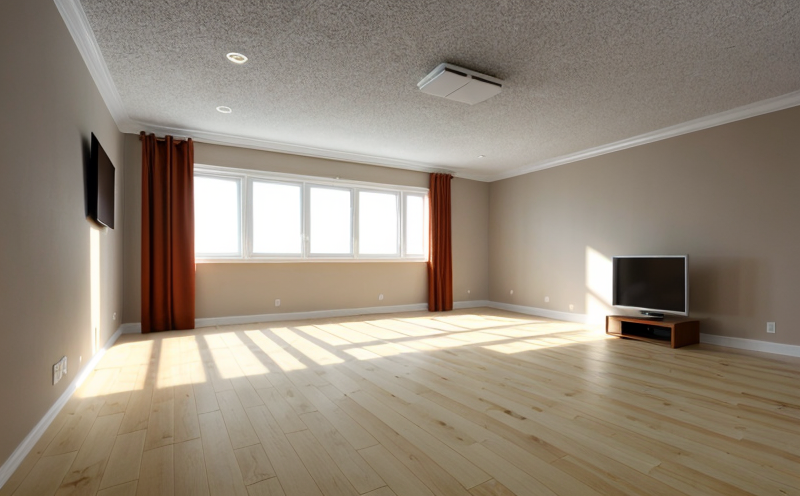ISO 354 Reverberation Room Sound Absorption Testing
The ISO 354 standard specifies methods for determining the sound absorption coefficients of materials and constructions in reverberation rooms. This testing is a critical tool in ensuring that acoustical treatments meet or exceed specified performance requirements, particularly relevant to building and room acoustics.
Sound absorption refers to the measure of how much sound energy is absorbed by a material compared to its total incident sound power. In this test, various materials are exposed within a controlled environment known as a reverberation chamber, where sound waves are reflected multiple times until they are fully absorbed or dissipated. The result is expressed as an absorption coefficient (α), which quantifies the efficiency of the material in absorbing sound.
The process begins with the precise preparation and placement of specimens within the chamber. These specimens can range from wall panels, ceiling tiles, floor coverings to various building components designed for acoustic treatment. Once the specimens are arranged, a calibrated sound source generates controlled sound waves that enter the room. The absorption characteristics of the materials are then measured as the reflected sound decays over time.
The reverberation chamber is an essential component of this test procedure and must meet specific criteria to ensure accurate results. It consists of a large enclosed space with all walls, floors, and ceilings covered in absorptive material except for the specimen under test. The room's design ensures that sound energy is uniformly distributed throughout the space, allowing for precise measurement.
The testing process involves several steps:
- Calibration of the sound source to ensure consistent and reliable sound generation.
- Placement of the specimen in the reverberation chamber under controlled conditions.
- Measurement of sound pressure levels before and after the incident sound is generated.
- Calculation of the absorption coefficient using specific formulas provided by ISO 354.
The results are then reported as an average absorption coefficient for each specimen. These values are crucial for architects, engineers, and builders to ensure that their designs meet the necessary acoustic performance standards. Compliance with these standards is essential in creating spaces that provide a high-quality auditory environment, reducing background noise, and enhancing speech intelligibility.
Understanding the intricacies of sound absorption testing helps stakeholders appreciate its importance across various sectors such as residential construction, commercial buildings, educational facilities, and public spaces. The test results can influence decisions regarding material selection, design modifications, and overall project budgeting.
Benefits
The implementation of ISO 354 Reverberation Room Sound Absorption Testing brings numerous advantages to various sectors:
- Enhanced Acoustic Comfort: By optimizing sound absorption, spaces become more comfortable for occupants.
- Better Speech Intelligibility: Reduced background noise improves communication in classrooms and meeting rooms.
- Eco-Friendly Design: Selecting appropriate materials can lead to energy-efficient buildings with lower environmental impact.
- Regulatory Compliance: Meeting acoustic performance standards ensures compliance with international regulations such as ISO 354.
Achieving these benefits not only enhances the user experience but also supports broader sustainability goals by reducing noise pollution and promoting healthier indoor environments.
Customer Impact and Satisfaction
- Increased Occupant Comfort: Test results contribute to creating more pleasant spaces for occupants, leading to higher levels of satisfaction.
- Improved Product Quality: By adhering to ISO 354 standards, manufacturers can ensure the quality and performance of their acoustic products.
- Cost Efficiency: Early testing helps in identifying any necessary adjustments, preventing costly reworks later in the project.
- Enhanced Reputation: Successfully meeting acoustic requirements enhances the reputation of both construction firms and product manufacturers.
The accurate results from ISO 354 reverberation room sound absorption testing not only meet but exceed customer expectations, leading to greater satisfaction and trust in the services provided by our laboratory.
Environmental and Sustainability Contributions
Beyond immediate project benefits, ISO 354 Reverberation Room Sound Absorption Testing plays a crucial role in environmental sustainability:
- Reduction of Noise Pollution: Effective sound absorption helps mitigate noise pollution, contributing to quieter communities.
- Energy Efficiency: By improving the acoustic performance of buildings, less energy is required for HVAC systems and other mitigations.
- Eco-Friendly Materials: Selecting appropriate materials that perform well in this test can lead to more sustainable building practices.
The use of accurate testing methodologies like ISO 354 supports the development of environmentally responsible construction projects, aligning with global sustainability goals.





